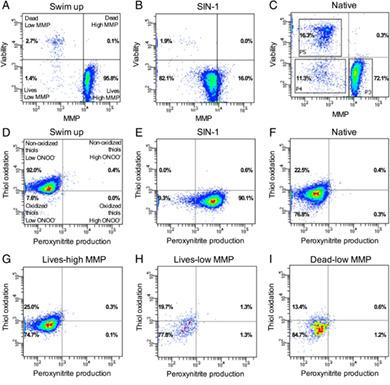当前位置:
X-MOL 学术
›
Cytom. Part A
›
论文详情
Our official English website, www.x-mol.net, welcomes your
feedback! (Note: you will need to create a separate account there.)
Multiparameter Flow Cytometry Assay for Analysis of Nitrosative Stress Status in Human Spermatozoa.
Cytometry Part A ( IF 2.5 ) Pub Date : 2020-06-12 , DOI: 10.1002/cyto.a.24170 Pamela Uribe 1, 2 , Juan Meriño 1 , Emilio Manquemilla 1 , Camila Villagrán 1 , Etelinda Vega 1 , Fabiola Zambrano 1, 3 , Mabel Schulz 1, 3 , Felipe Pezo 1 , Juana V Villegas 2, 4 , Rodrigo Boguen 5 , Raúl Sánchez 1, 3
Cytometry Part A ( IF 2.5 ) Pub Date : 2020-06-12 , DOI: 10.1002/cyto.a.24170 Pamela Uribe 1, 2 , Juan Meriño 1 , Emilio Manquemilla 1 , Camila Villagrán 1 , Etelinda Vega 1 , Fabiola Zambrano 1, 3 , Mabel Schulz 1, 3 , Felipe Pezo 1 , Juana V Villegas 2, 4 , Rodrigo Boguen 5 , Raúl Sánchez 1, 3
Affiliation

|
Male infertility is an increasing health problem, and oxidative/nitrosative stress plays an important role in the etiology of this condition. Nitrosative stress due to excessive levels of reactive nitrogen species (RNS) is associated with impaired male fertility. Flow cytometry may be a useful tool for semen evaluation, but the availability of multiparameter assays for analysis of sperm quality is limited. The present study standardized a multiparameter flow cytometry analysis for nitrosative stress status in human spermatozoa in a single assay. A suitable multicolor fluorochrome panel was designed and consisted of fluorescein‐boronate to detect peroxynitrite, a highly RNS, propidium iodide to analyze viability, tetramethylrhodamine methyl ester perchlorate to detect mitochondrial membrane potential (MMP) and monobromobimane to analyze thiol oxidation. Proper positive and negative controls for each fluorochrome were used to establish the technique, and sperm cells of different qualities and spermatozoa subjected to cryopreservation were analyzed. The results showed that the controls clearly discriminated between the high and low fluorescence intensities for each fluorochrome. The analysis of sperm cells of different quality demonstrated that the assay properly detected differences in all parameters analyzed according to sperm quality. The results may be reported as the mean fluorescence intensity of each fluorochrome and the percentage of cells exhibiting different characteristics. In conclusion, a protocol was standardized to analyze nitrosative stress status, including peroxynitrite production, viability, MMP, and thiol oxidation, in a single analysis using flow cytometry. This protocol may be applied to research approaches and clinical andrology to improve the evaluation of sperm quality and provide a promising tool to increase the use of clinical flow cytometry. © 2020 International Society for Advancement of Cytometry
中文翻译:

用于分析人类精子亚硝化应激状态的多参数流式细胞术分析。
男性不育是一个日益严重的健康问题,氧化/亚硝化应激在这种疾病的病因学中起着重要作用。由于活性氮物质 (RNS) 水平过高而导致的亚硝化应激与男性生育能力受损有关。流式细胞术可能是精液评估的有用工具,但用于分析精子质量的多参数测定的可用性有限。本研究在单一分析中标准化了人类精子亚硝化应激状态的多参数流式细胞术分析。设计了一个合适的多色荧光染料面板,由荧光素-硼酸盐组成,用于检测过氧亚硝酸盐,一种高度 RNS,碘化丙啶,用于分析活力,用四甲基罗丹明甲酯高氯酸盐检测线粒体膜电位 (MMP),用单溴二甲醚分析硫醇氧化。使用每种荧光染料的适当阳性和阴性对照来建立该技术,并对不同质量的精子细胞和冷冻保存的精子进行分析。结果表明,对照可以清楚地区分每种荧光染料的高荧光强度和低荧光强度。对不同质量的精子细胞的分析表明,该测定正确检测了根据精子质量分析的所有参数的差异。结果可以报告为每种荧光染料的平均荧光强度和表现出不同特征的细胞百分比。总之,使用流式细胞术在单次分析中对亚硝化应激状态进行了标准化,包括过氧亚硝酸盐的产生、活力、MMP 和硫醇氧化。该协议可应用于研究方法和临床男科学,以提高对精子质量的评估,并为增加临床流式细胞术的使用提供有前途的工具。© 2020 国际细胞计量学促进会
更新日期:2020-06-12
中文翻译:

用于分析人类精子亚硝化应激状态的多参数流式细胞术分析。
男性不育是一个日益严重的健康问题,氧化/亚硝化应激在这种疾病的病因学中起着重要作用。由于活性氮物质 (RNS) 水平过高而导致的亚硝化应激与男性生育能力受损有关。流式细胞术可能是精液评估的有用工具,但用于分析精子质量的多参数测定的可用性有限。本研究在单一分析中标准化了人类精子亚硝化应激状态的多参数流式细胞术分析。设计了一个合适的多色荧光染料面板,由荧光素-硼酸盐组成,用于检测过氧亚硝酸盐,一种高度 RNS,碘化丙啶,用于分析活力,用四甲基罗丹明甲酯高氯酸盐检测线粒体膜电位 (MMP),用单溴二甲醚分析硫醇氧化。使用每种荧光染料的适当阳性和阴性对照来建立该技术,并对不同质量的精子细胞和冷冻保存的精子进行分析。结果表明,对照可以清楚地区分每种荧光染料的高荧光强度和低荧光强度。对不同质量的精子细胞的分析表明,该测定正确检测了根据精子质量分析的所有参数的差异。结果可以报告为每种荧光染料的平均荧光强度和表现出不同特征的细胞百分比。总之,使用流式细胞术在单次分析中对亚硝化应激状态进行了标准化,包括过氧亚硝酸盐的产生、活力、MMP 和硫醇氧化。该协议可应用于研究方法和临床男科学,以提高对精子质量的评估,并为增加临床流式细胞术的使用提供有前途的工具。© 2020 国际细胞计量学促进会











































 京公网安备 11010802027423号
京公网安备 11010802027423号